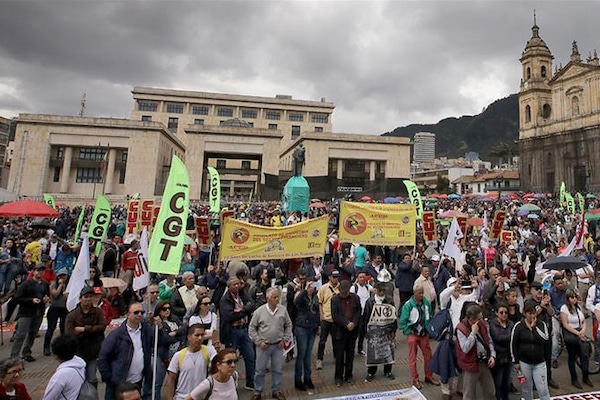by JUSTIN PODUR

The sustained protests are part of a larger trend against austerity and endless war.
The protests that started with the national strike called by Colombia’s central union on November 21 to protest pension reforms and the broken promises of the peace accords have persisted for two months and grown into a protest against the whole establishment. And the protests have continued into the new year and show no signs of stopping.
The end of the decade has seemed to bring an unstoppable march of the right wing in Latin America as elsewhere. The 2016 coup in Brazil that ended with fascist Jair Bolsonaro in power, the 2019 coup in Bolivia, the continuously rolling coup in Venezuela, all showcased the ruthlessness of the U.S. in disposing of left-wing governments in the region. Right-wing victories at the ballot box occurred in Chile in 2017 and in Colombia in 2018, where the electorate rejected the left-wing Gustavo Petro and embraced Iván Duque, a protege of the infamous former president Álvaro Uribe Vélez. But with the new wave of protests, the unstoppable right-wing juggernaut is facing many challenges.
In Chile, three months of protests, still going, are demanding the resignation of President Sebastián Piñera and the reversal of a range of neoliberal policies. Even in the face of the police and army using live fire against protesters, they have not let up.
Ecuador is another peculiar case, in which Lenín Moreno ran as a candidate who would continue left-wing policies, but who promptly reversed course upon reaching power in 2017, including revoking the asylum of Julian Assange, who is now in a UK prison. Reopening drilling in the Amazon, opening a new U.S. airbase in the Galapagos, getting rid of taxes on the wealthy, and doing a new package of International Monetary Fund austerity measures was enough to spark a sustained protest. Moreno’s government was forced to negotiate with the protesters and has withdrawn some of the austerity measures.
In Haiti, protests have gone on for over a year. Sparked in July 2018 by a sharp increase in fuel prices (the same spark as for the Ecuador protests), they have expanded to call for the president’s resignation. In Haiti, as the protests have dragged on, some of the country’s elite families have joined the call for the president’s resignation, which will make it even more difficult to find a constitutional exit from the crisis.
In Colombia, after winning the runoff in 2018, President Duque may have felt that he had a mandate to enact right-wing policies, which in Colombia have usually included new war measures in addition to the usual austerity. But combining pension cuts with betraying the peace process was simply stealing too much from the future: Young people joined the November 21 protests in huge numbers (the lowest estimates are 250,000).
The sustained nature of the protests is striking. Rather than one-offs, the protests have been committed to staying on until change is won. We may hear more this year from post-coup Brazil and Bolivia as well.
Monthly Review Online for more
